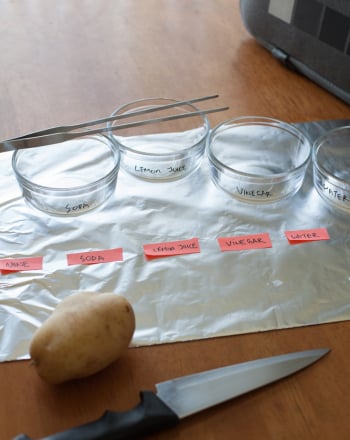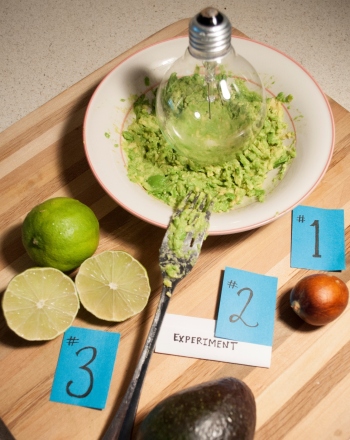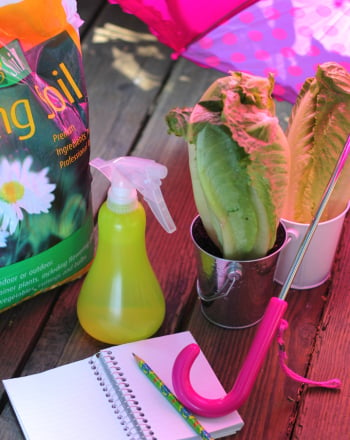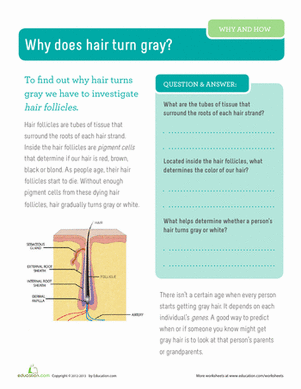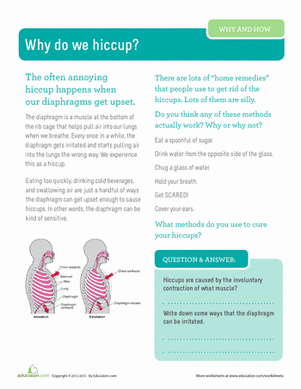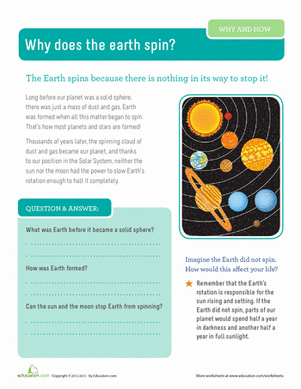Science project
Why Do Greens Turn Brown?
Difficulty of Project
Easy
Approximate Cost
$8.00 for lettuce (both red and green), paper towels, and poster board
Safety Issues
Adult supervision may be needed in using a knife to cut the salad greens.
Approximate Time to Complete the Project
One week
Objective
Eating salad is refreshing because we get to eat living vegetables. However, it is unappetizing to have green leaves turn brown and wilt on your plate. In a series of experiments, students will learn about why fresh vegetables age so quickly, and what factors speed up the browning process. They will learn how the surface tension of the salad oil, the permeability of the waxy leaf cuticle, and the spongy air spaces in the leaf all affect browning and wilting.
Project Goal
The goal is for young children to examine browning and wilting of salad greens.
Materials and Equipment
- Green lettuce
- Red lettuce
- Microscope (optional)
- Knife for cutting the greens
- Paper towels
- Vinegar (Use any kind of clear vinegar. Darker vinegars such as apple cider vinegar will work, but the color will make it harder to distinguish plant pigments from the vinegar on paper towels.)
- Salad oil (peanut, olive, canola or other vegetable oils are fine)
Introduction
Background Information
As you can imagine, food scientists have been studying why plants turn brown for a long time. Some of the very first enzymes ever discovered back in the 1880’s were those that make lacquer from trees turn brown. Since that time, we have learned that a class of enzymes called polyphenol oxidases is responsible for the browning of vegetables. While polyphenol oxidases may cause our nice green salads to turn brown in a day or so, the way we handle salad greens also speeds up the process. The “cut or tear” debate has raged for generations. Folks who claim that tearing minimizes browning usually argue that it rips apart fewer cells. However, this argument isn’t necessarily a good one. Sometimes a group of cells in a plant are bound more tightly together than any individual cell. Evidence suggests that the more fragile the leaves, the more vulnerable they are to cutting. Thus, while students may see little difference between the cut and torn lettuce leaves, there will be an appreciable difference between the cut and torn basil leaves.
Dressing salads also speeds up browning and wilting because the oil and vinegar have an enormous effect on the cells on the plant. Individual leaves have a waxy cuticle covering them. They also have large air spaces inside to help with gas transfer during photosynthesis. These tiny air spaces are why a large volume of spinach will shrink down when heated. The waxy cuticle and the air spaces are also affected by how we treat our greens.
Predictably, the acidic vinegar used in salad dressing is hard on salad greens. Students will observe that the white paper towels have tell-tale stains of plant pigments leaking out of red lettuce leaves. However, the big surprise is how leaves respond when they are dressed in oil. While the waxy cuticle causes water to bead up on the leaf, oil doesn’t bead up, but flows directly into the air pockets in the leaf. Students may be able to observe tiny air bubbles exiting an oil-soaked leaf under the microscope. Some students may also appreciate the difference between the surface tension of the oil and the surface tension of the water. Students will observe that oil damages lettuce leaves far more quickly than vinegar. Given these results, dressing should be added to salads immediately before eating!
Research Questions
- Does cutting the salad greens make them brown faster than tearing? Is there a difference between fragile greens such as basil and sturdier greens such as romaine?
- Does a mild acid such as the vinegar found in salad dressing affect the speed of browning and wilting?
- Is the surface tension of salad dressing related to the speed of browning? Why?
- How does the waxy cuticle found in leaves relate to browning? How so?
- How does the spongy structure of leaves relate to wilting?
Terms, Concepts and Questions to Start Background Research
- Browning
- Enzymatic action
- Polyphenol oxidase
- Cuticle
- Cellular structure of a leaf
- Surface tension
Experimental Procedure
Experiment #1
- Cut up some sturdy romaine leaves. Put them in a place where they will not be disturbed for two days.
- Tear some sturdy romaine leaves. Try tearing along the ridges of leaves and wherever the tear seems most natural. Put the torn leaves in place where they will not be disturbed for two days.
- Leave some untouched romaine leaves undisturbed for two days. These are your controls.
- Repeat steps one, two, and three with fragile basil leaves.
- Inspect your leaves at six hours, 12 hours, 18 hours, 24 hours, 36 hours and 48 hours. Which has browned the most? Is there a difference between the controls and the other leaves? Is there a difference between the cut and torn leaves? What about between the basil and the romaine leaves? Write up your observations. Take pictures.
Experiment #2
- Lightly dress some red lettuce leaves with vinegar. Any kind of clear vinegar will do. Leave the vinegar-dressed leaves on white paper towels. Leave some undressed leaves on white paper towels as controls.
- Inspect the lettuce leaves at twenty minutes, a half hour, 1 hour, and 2 hours. Look at the paper towels closely. Is there any evidence of paper towels getting stained by pigments leaking out of damaged cells?
- Inspect a portion of the control leaves and the vinegar-soaked leaves under a microscope. Draw what you see.
Experiment #3
- Lightly dress some lettuce leaves with vegetable oil (any kind of lettuce work well for this). Dress some other lettuce leaves with water.
- Inspect the lettuce leaves immediately after dressing them, and at 10 minutes and 20 minutes Do the water and oil bead up or spread out on the leaves? What happens to the texture of the leaves?
- Inspect the leaves under a microscope. Using a pin, poke a hole into one of the oil-soaked leaves and watch carefully under the microscope for several minutes. What do you see?
- Write up your observations. Take pictures!
Bibliography
- The Curious Cook by Harold McGee
- McGill Office for Science and Society "Why Does Lettuce Sometimes Turn Brown?"
Education.com provides the Science Fair Project Ideas for informational purposes only. Education.com does not make any guarantee or representation regarding the Science Fair Project Ideas and is not responsible or liable for any loss or damage, directly or indirectly, caused by your use of such information. By accessing the Science Fair Project Ideas, you waive and renounce any claims against Education.com that arise thereof. In addition, your access to Education.com's website and Science Fair Project Ideas is covered by Education.com's Privacy Policy and site Terms of Use, which include limitations on Education.com's liability.
Warning is hereby given that not all Project Ideas are appropriate for all individuals or in all circumstances. Implementation of any Science Project Idea should be undertaken only in appropriate settings and with appropriate parental or other supervision. Reading and following the safety precautions of all materials used in a project is the sole responsibility of each individual. For further information, consult your state's handbook of Science Safety.

